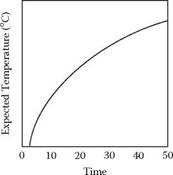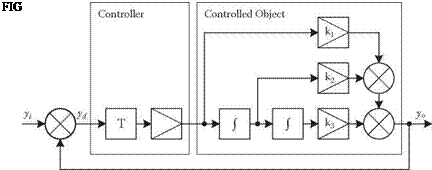A human operator can become just as important a component in a regulatory or control system as the electronic or mechanical components. Constant regulation (where the operator puts in new set values at certain intervals—running orders) is normally found in industrial processes. The concept of ‘controller’ should only be used where the worker is an ‘online’ part of the regulatory system; otherwise, the more general term ‘operator’ is usually used.
When someone is controlling a car, he or she has to carry out a number of mental differentiations and integrations, depending on the response produced to the input quantity (see Figure 2.12). Similar conditions exist for many other control tasks, for example, steering a ship. A human being’s ability to carry out these mental processes successfully is relatively limited. Two French researchers (Tarriere and Wis – ner, 1963) showed that fatigue produces very strong oscillations when controlling a car. The ability to carry out the necessary integrations and differentiations clearly worsens with fatigue.
The task of controlling a machine can be made easier by introducing various aids (off-loading mechanisms) for performing the integrating and differentiating tasks. There are two main types of such mechanisms:
1. Influence the controlled object directly, and thereby the actual value (‘A’ mechanisms—Aiding);
2. Influence the feedback, and thereby the information to the human operator (‘Q’ mechanisms—Quickening).
 |
Introduction of an ‘A’ mechanism, as shown in Figure 2.13, brings about a reduction in the worker’s load, as certain calculations no longer need to be carried out. Also, the aiding mechanism, which lightens the load concomitantly makes the system faster. Without this mechanism, the operator’s control output of the system is affected. As the quantities within the system are fed back continuously to the operators, they will be immediately aware of changes, which occur as a result of their actions.
Simplification of the controller’s task using an ‘A’-simplifying mechanism works preliminarily in two ways:
1. By relieving the operator of certain operations
2. By giving information more rapidly about changes in the process
‘A’-simplified mechanisms cannot be used where it is impossible to make the technical changes which will directly affect the output quantity of the controlled object. These output quantities may depend on quantities that cannot be controlled, such as wind, waves, and similar aerodynamic and hydrodynamic relationships. In such cases, a ‘Q’-simplifying mechanism can be used. ‘Q’-simplifying mechanisms do not work directly on the output quantities of a system, but they change and simplify the information which is presented to the controller. There are different types of ‘Q’ simplification:
1. Predictive ‘Q’ information
2. Complete ‘Q’ information
3. Partial ‘Q’ information
The need for ‘Q’-simplified mechanisms occurs in many industrial processes, such as the starting up of a process where certain values (for example, temperatures) have to be increased according to a particular time plan. Such systems often have considerable inertia, which means that there is no direct relationship between control movements and the output of the system, and it takes a long time before any result can be read from the instruments.
The operator has a control level whose movement (input quantity to the process) is integrated a number of times before the desired temperature change (output quantity from the process) is obtained. In such cases the desired temperature sequence cannot be set. In order to improve the performance of the operator, the temperature (output quantity) can be differentiated a suitable number of times, and this information will then form the basis of an automatic calculation (prediction) of the temperatures at various times in the future for different degrees of control movement. These expected temperatures can be presented as a curve on a screen, on which the desired temperature sequence can also be displayed. Figure 2.14 shows the required sequence of values marked as a line on the screen. The prediction of the course of

 |
the change for the actual control movement is automatically calculated and should normally be shadowed by the line which shows the desired sequence. In this way, any deviations can be seen very quickly. This is shown as predictive ‘Q’ information.
In modern industrial processes there is no direct regulation; the operator sets in the desired values at certain times, and the process is automatically controlled within these values (technical constant regulation). Starting and stopping of the process is done with what are known as
FIGURE 2.14 Predicted values presented
on a display. group starts, where one control is used to
initiate the start-up, in the correct sequence, of whole groups of motors, valves, and so on. This is often thought to be necessary so that the handling of the process will be sufficiently rapid or accurate. Predictive ‘Q’ information should probably be used here as an alternative or an addition, as this would provide the operator with a better understanding of how the process works. The work would also be more interesting, which in turn could lead to the process being better controlled.
Figure 2.15 shows a system containing four integrating elements. One example of a machine which operates in this way is a submarine. When a change is made to the depth control of a submarine, it takes a long time before a result is obtained in the form of a new stabilised depth being reached. Also, the movement of the control is not proportional to the movement of the depth control integrated (in this example) four times. Because the movement of the submarine also depends to a large extent on water currents, hydrodynamic forces, and other external factors, the output—that is, the ultimate depth—cannot be influenced by an aiding mechanism which will directly affect the movement of the vessel, and thereby the output quantity. It is also very difficult to control the submarine solely with the aid of a depth gauge. One alternative is to feed information back directly to the operator on what is happening to the submarine at different stages, as shown in Figure 2.16. This is known as complete ‘Q’ information. Instruments continuously measure the depth, vertical position, change of depth, or diving angle with time (first time derivative of the output), rate of change of diving angle (second derivative of the output), and the acceleration of the diving angle (third derivative of the output).
In order for the ‘Q’-simplifying mechanism to function correctly, the constants in Figure 2.16 must be very carefully determined. There is no complete theoretical method for determining these constants, but their optimal values can often be deduced with the aid of analogue computers set up to simulate the system in question. The derivative which is weighted with the output quantity to produce the feedback need not be a time derivative but could also be a position derivative, for example. Where it is not possible to measure the different derivatives directly, they can be calculated indirectly using, for example, electronic differentiation.
As a summary of the human ability to function as a continuous controller in a system, it maybe stated that the tasks performed should be as simple as possible in purely mathematical terms. If possible, they should not be more complex in practice than a person functioning as a simple amplifier, that is, no differentiation or integration is required. With the aiding mechanisms described here, it is feasible to introduce tasks specially matched to a worker’s performance abilities.
The types of models described so far represent simple control circuits, for example, control of speed in a car or the position of the car on the road. They have their
FIGURE 2.15 System containing several integrating elements.
|
|
|
|
|
|

primary practical applications in the control of, for example, aeroplanes, cars, and ships. As far as the control of more complex processes within the process industries is concerned, these types of models are only of importance for the understanding of the control of the individual process parameters. A process industry, on the other hand, consists of a large number of parameters, commonly several hundred. When the operator is functioning directly in the control loop, however, it is important to understand these theoretical basics first.


